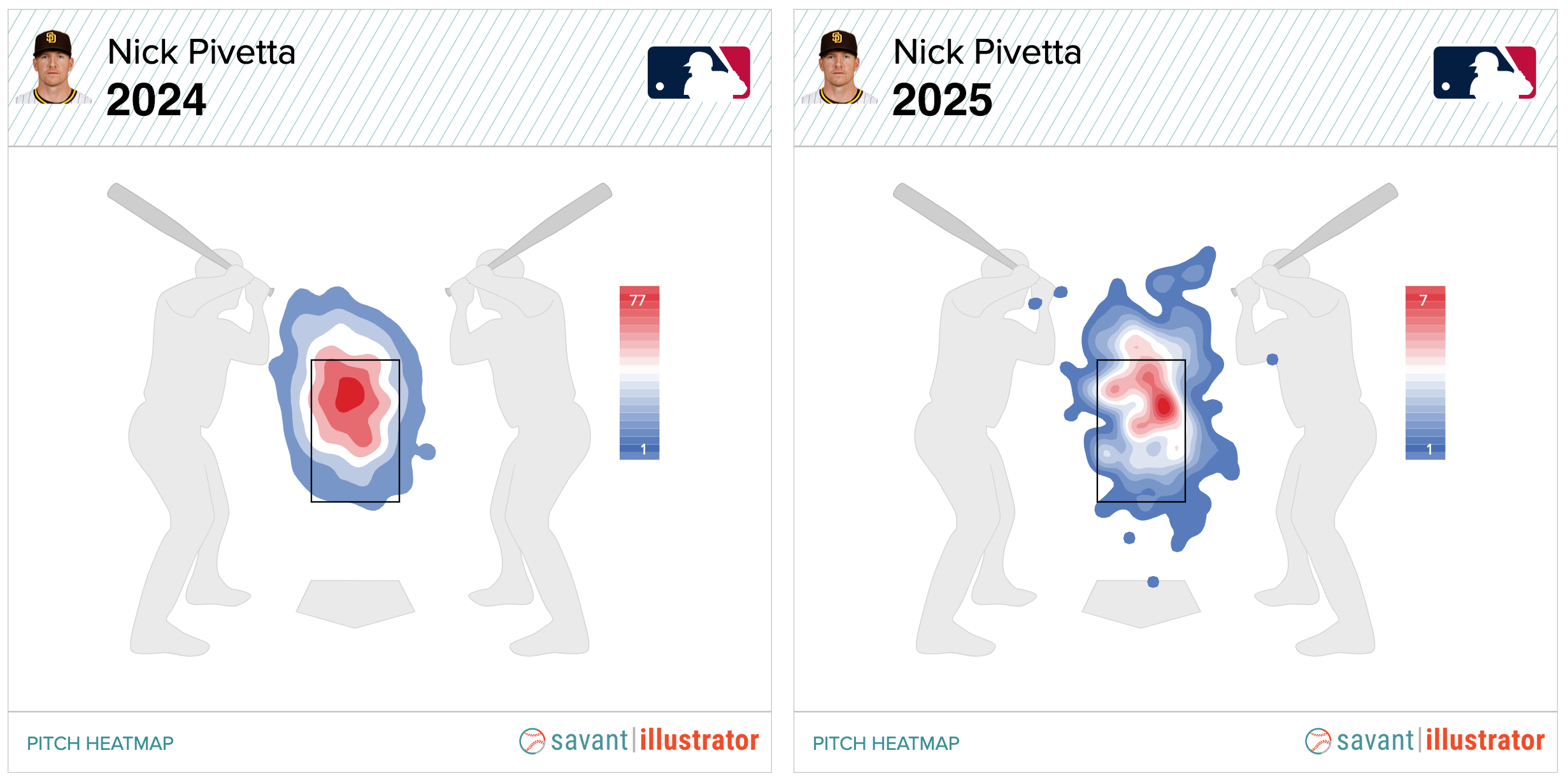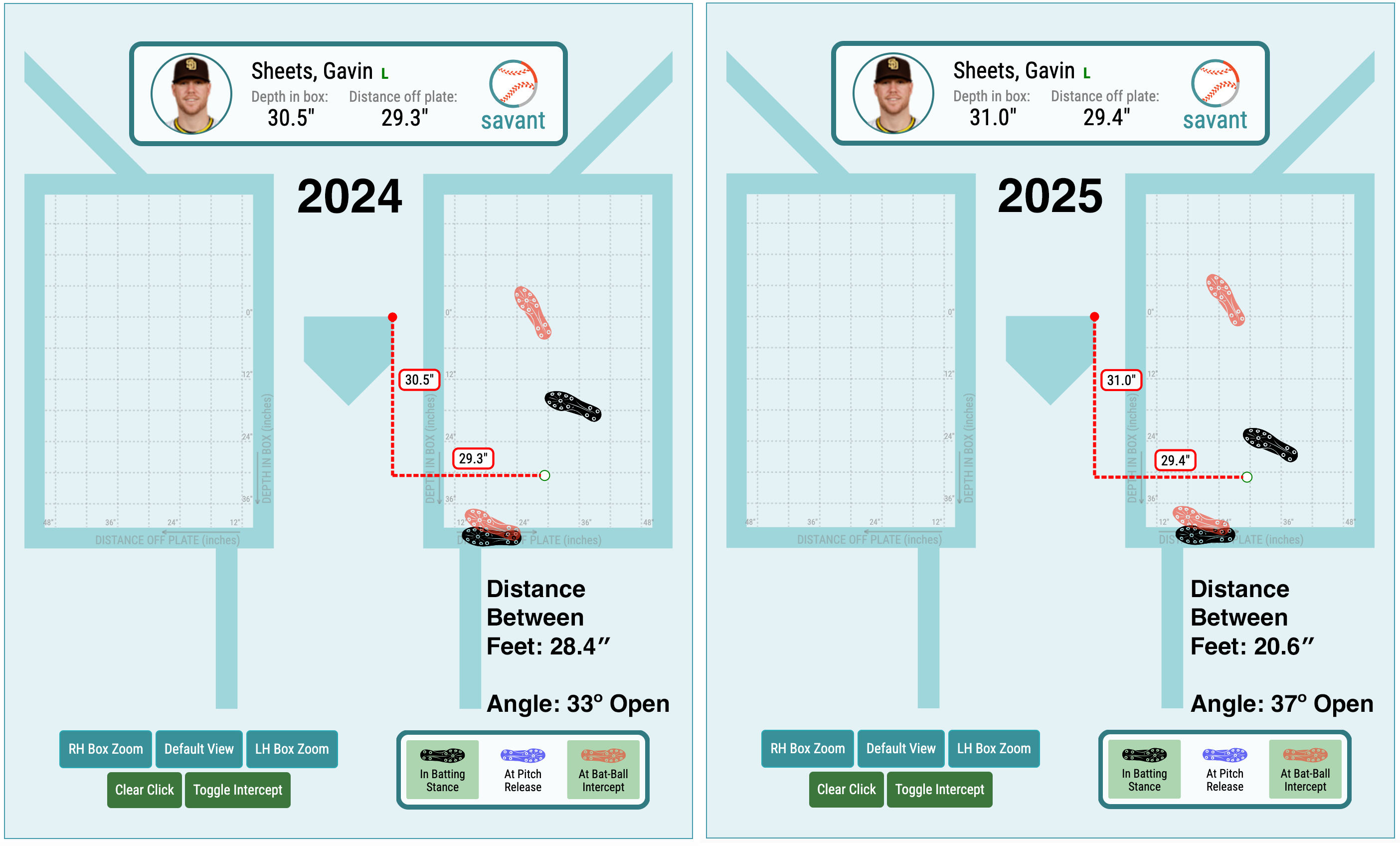When the Padres signed Nick Pivetta to a four-year, $55 million deal in mid-February, it marked an awakening from a sleepy and disappointing winter. With ownership embroiled in a battle over who would control the team in the wake of Peter Seidler’s death, San Diego had let several key free agents from last year’s 93-win Wild Card team depart, including Jurickson Profar and Ha-Seong Kim, but hadn’t spent more than $3.5 million or issued a contract longer than a year when it came to restocking. Pivetta was the exception, and while he was signed to be the fourth starter behind Dylan Cease, Michael King, and Yu Darvish, so far he’s been the stingiest rotation member on the hottest team in baseball.
On Wednesday afternoon at Petco Park, Pivetta spun six innings of one-run ball against the Cubs, allowing just four hits and striking out six, while Manny Machado and Fernando Tatis Jr. each drove in a pair of runs. Though reliever Wandy Peralta served up a solo homer to Pete Crow-Armstrong in the eighth inning — the rare lapse by a bullpen that’s been lights out so far — the Padres won 4-2. After beginning the season with seven straight wins over the Braves and Guardians, and winning their first 11 games at home before losing to the Cubs on Tuesday, they’re now a major league-best 15-4, outdistancing the world champion Dodgers, who have played just .500 ball since opening the season 8-0.
Though San Diego swept the Braves in the Wild Card Series last year and then went the distance with the Dodgers in the Division Series before getting eliminated, this season’s club wasn’t expected to be a particularly strong one in light of its offseason inactivity, which also included losing reliever Tanner Scott and catcher Kyle Higashioka to free agency. The Padres replaced Profar — who had followed up a career-worst season with a career-best one that earned him his first All-Star selection — in left field with a platoon built around 35-year-old Jason Heyward, whom they signed for one year and $1 million. They went light at catcher following Higashioka’s departure, cobbling together a tandem of Elias Díaz and Martín Maldonado, two backstops who were released by their respective teams last summer; San Diego had added Diaz after he was dropped by the Rockies in August, then retained him on a one-year, $3.5 million deal. The Padres appeared so geared toward reining in spending that the Pivetta move was initially presumed to be a precursor to trading Cease.
Entering the season, our Playoff Odds forecasted the not-so-refreshed Padres for just a .503 winning percentage (81.5 wins) with a 3% chance of taking the NL West and a 32.9% chance of making the playoffs, with the Dodgers and Diamondbacks — who won 89 games last year but missed the playoffs due to a tiebreaker — both looming large. Yet the Padres have matched their best start since 1998, when they went on to win just their second NL pennant. Their record has been earned this season; they’ve gone 5-1 in one-run games (Tuesday night’s 10-inning, 2-1 defeat was their first such loss) and 6-2 in games decided by five or more runs. Their +43 run differential is the best in the majors, and they’re only about one win ahead of their Pythagenpat and BaseRuns winning percentages (.724 and .742, respectively), both of which are also tops.
The biggest driver of San Diego’s success thus far has been run prevention, as the team is allowing just 2.68 runs per game and has shut out opponents six times — marks that both lead the majors. The Padres shut out the Rockies in three consecutive games from April 11–13, something they’d never done to a single opponent in the 56-season history of the franchise. (San Diego had spread streaks of three or four shutout games over multiple opponents.) Before silencing Colorado, the Padres blanked the Braves in back-to-back games on March 29 and 30, and the Guardians on April 1. They’ve outscored opponents 67-19 in 13 games at Petco Park, and in their most recent series, they held the Cubs — who have averaged a major league-high 5.90 runs per game — to eight runs over three games.
The Padres have done this despite a rotation that’s missing Joe Musgrove, who had Tommy John surgery in October, and has been without Darvish due to elbow inflammation. Pivetta has never finished a season with an ERA below 4.04, and owns a career mark of 4.71, but through four starts he’s at 1.57 — perhaps a fine argument for dismissing all of this as small sample theater. The 32-year-old righty’s propensity for serving up home runs is a big reason for those swollen ERAs. He’s never finished a season with a home run rate below 1.32 per nine, and his career mark of 1.51 per nine ranks fifth among active pitchers with at least 500 innings, but so far, he’s served up just one in 23 innings. He’s done an excellent job of avoiding hard contact in general, with a career-low average exit velocity (87.8 mph), and his lowest HardHit% (35.1%), barrel rate (7.0%), and pulled air rate (15.8%) in at least half a decade.
The main difference in Pivetta’s approach so far is that he’s getting more arm-side run on his four-seamer than last year, and even more run with a sinker that he’s restored to his arsenal. (He throws it 6.2% of the time.) He’s done a better job of keeping his four-seamer out of the middle of the strike zone, and batters have whiffed on 29.6% of their swings against it, up from 21.9% last year.

King was knocked out in the third inning by the Braves on Opening Day, though the Padres still won. Since then, he’s allowed just 12 hits and two runs in 19 2/3 innings over three starts, the last of which was a two-hit shutout against the Rockies, one of just two shutouts in the majors this season. He’s carrying a 2.42 ERA and 3.23 FIP so far. The rest of the rotation has been more of a mixed bag. While Cease (who’s still a Padre) is carrying a 6.64 ERA, that’s mainly a product of a nine-run, four-inning drubbing by the A’s in Sacramento on April 8; he’s allowed just six earned runs in 16 1/3 innings in his other three turns, and both his 2.96 FIP and 3.77 xERA underscore the respectable job he’s done. Randy Vásquez has a 1.74 ERA despite walking 14 batters and striking out just eight in 20 2/3 innings; he’s survived thanks to a 31.3% HardHit%, which ranks seventh in the majors, but that’s not something you’d want to bet on continuing given his pedestrian stuff. Kyle Hart, whom the Padres signed in February after he won last season’s Choi Dong-won Award, the KBO’s equivalent to the Cy Young, has ugly numbers because of a five-run, two-out start against the Cubs on April 6, but in his most recent turn, on Saturday, he held the Rockies to one hit over six scoreless innings.
As for Darvish, he’s playing long toss but has yet to resume throwing off a mound, so he’s unlikely to return to the rotation before mid-May. Also down currently is Matt Waldron, who’s on the 60-day injured list with an oblique strain, and who lost his spot in the rotation late last season. For as well as it’s going for the Padres, they don’t have a lot of depth to spare with their starters.
While the rotation has been very good in the aggregate, with both its 3.31 ERA and 3.37 FIP ranking among the majors’ top seven, the bullpen has been even more stifling, posting a best-in-baseball 1.52 ERA, plus a 3.12 FIP, with a 27.5% strikeout rate (fifth best). San Diego has played enough close games that closer Robert Suarez already has a majors-leading eight saves; he didn’t even allow a hit until his seventh appearance, and has yielded just three hits and two walks through nine scoreless innings. The three setup men in front of him, righties Jason Adam and Jeremiah Estrada, and lefty Adrian Morejon, have each allowed just one run while combining for 30 innings. In fact, six of the nine relievers the Padres have used have ERAs of 1.29 or lower, with five of those six with a 2.49 FIP or lower as well.
The late-game righties mix it up as far as angles and repertoires. Estrada, typically the seventh-inning guy, throws from the steepest arm angle of any pitcher in the majors, 65 degrees, with a four-seamer that averages 97.5 mph, a slider, and a splitter. Adam, generally the eighth-inning guy, throws from a 37-degree angle, and uses his changeup and slider more than his four-seamer. Suarez comes in at a 44-degree angle, with a four-seamer that averages 98.2 mph, as well as a changeup and sinker. The trio is missing plenty of bats, with Estrada punching out 38.9% of all hitters, Adam 37.5%, and Suarez 31.3%.
Meanwhile, the offense has scored a potent 4.63 runs per game while posting a 120 wRC+ (seventh in the majors) and a .274/.348/.416 slash line. The stars — Machado, Tatis Jr., and Jackson Merrill — have been leading the way. Machado is hitting .324/.392/.521 (159 wRC+), a vast improvement on last year’s early going, when he was limited to DH duty as he recovered from offseason surgery to alleviate tennis elbow in his right arm; he carried an 86 wRC+ through May. He’s also 6-for-6 in steals, putting him more than halfway to last year’s total of 11.
Tatis is hitting .348/.425/.623 (193 wRC+) and is tied for the NL lead with six home runs, that after hitting a modest 21 in 102 games last year. Five of those homers have come in his last eight games, including a pair against the Cubs on Monday night.
Tatis has a 12.5% walk rate while striking out just 11.3% of the time, about half as often as last season. One can understand the hesitance of opposing pitchers to throw him strikes given that he’s hitting the ball so hard. He’s fifth in the majors with a .722 xSLG.
Merrill is hitting .378/.415/.676 (203 wRC+) with three homers and a .774 xSLG (second only to Aaron Judge), though he landed on the injured list after straining his right hamstring on April 6. He has yet to resume jogging, so he won’t be coming off the IL when he’s first eligible on Friday. Light-hitting backup center fielder Brandon Lockridge spent a week covering for Merrill before straining his left hamstring, and so over the last three games, manager Mike Shildt has started Heyward in center field once and superutilityman Tyler Wade twice.
The Padres have also been without Jake Cronenworth, who got off to a hot start (.257/.409/.486, 160 wRC+) before suffering a fractured right rib when he was hit by a pitch on April 6. Initially, he assumed he had only suffered a bruise, and he even homered off A’s righty Luis Severino the next night, but continued pain led to an MRI that revealed a non-displaced fracture. Jose Iglesias has been filling in, providing immaculate vibes and his share of hits.
The offense has received surprising support from Gavin Sheets, whom the White Sox non-tendered last November and whom the Padres signed to a minor league deal in February. The 28-year-old lefty, a former second-round pick, produced diminishing returns in Chicago after an impressive 54-game rookie season in 2021. Last year, he hit just .233/.303/.357 (88 wRC+), with a negative WAR for the second straight season. So far, he’s hitting .311/.373/.489 (145 wRC+) as the long half of a DH platoon with Yuli Gurriel.
Sheets spent time this winter with his father, former major leaguer Larry Sheets, to retool his approach and his swing, and the work has continued with hitting coach Victor Rodriguez (the elder Sheets’ former roommate in the minors), assistant hitting coach Mike McCoy, and sports science director Nathan Landau.
“It just showed me some stuff in my posture with my body, getting it to move in a better direction, getting it to be in a better spot to where I can fire off my ‘A’ swing,” Sheets said of the biomechanical help he’s received. “If I can clean up my posture and know where my body is at all times, I feel like I can get off my ‘A’ swing. Just getting my body more athletic and using it in my swing in the right way.”
Statcast’s new batting stance data show that Sheets is using a slightly more open stance, with his feet about 8 inches closer together relative to last year. His average bat speed has increased by 1 mph (from 72.7 mph to 73.7 mph), he’s getting to his fast swing more often (from 29.7% to 41.7%), and both his squared-up and blast rates have improved incrementally.

Given that Sheets was similarly hot in April last year (.279/.376/.465, 141 wRC+), it’s a bit early to declare his transformation a full success, and likewise for Pivetta and the rest of the Padres. Still, in an ultracompetitive division that includes four teams playing very good baseball (the Giants are 13-5, the Dodgers 14-6, and the Diamondbacks 11-7), banking these early wins while their roster is at less than full strength can only help the Padres’ chances of another trip to the playoffs.















